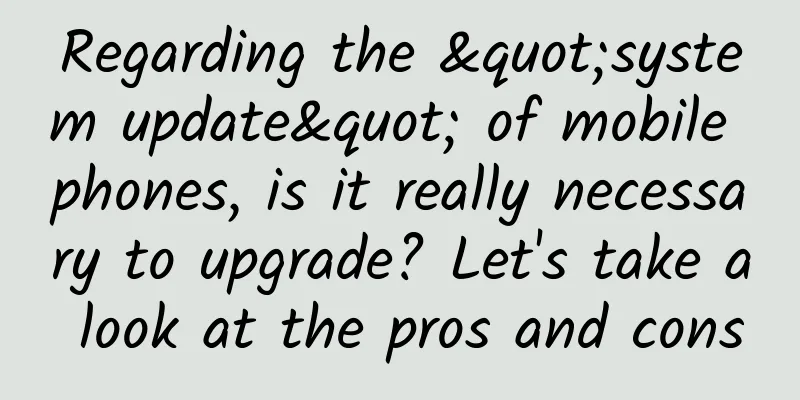Regarding the "system update" of mobile phones, is it really necessary to upgrade? Let's take a look at the pros and cons

|
On weekdays, your phone will pop up a reminder about "system update" every once in a while. Upgrading the system is not a must, and it depends on the user's phone. Let's first take a look at the advantages and disadvantages of updating the phone system.
The advantages of a mobile phone system update are roughly the ones listed above, but it is not enough to only look at the advantages. There are actually quite a few disadvantages after the system update. The first disadvantage is that it may increase the power consumption of the mobile phone . The system and the software and hardware of the mobile phone are highly matched when the mobile phone is pre-installed at the factory, but there may be some differences after the system is updated, and running these software and hardware may consume more power afterwards. The second disadvantage is that the downloaded software is incompatible. The mobile phone system is updated, but the software manufacturers may not update in real time, so some software may not run after the system is updated. The third disadvantage is that it takes up more mobile phone memory, which is unavoidable. Upgrades and updates will definitely add some new things to the phone, which will definitely take up more memory. The fourth disadvantage is that some unstable situations may occur, such as the phone freezing, severe heating, etc. This is because the user's model configuration has not kept up with the mainstream. In conclusion, if your phone model and configuration are new enough, then choose to update the system. If your phone gets seriously hot after a short period of use, is always stuck, and consumes power quickly, then don't update it. Whether to update the system depends on whether your phone belongs to the former or the latter. |
<<: Surpassing QQ: WeChat has become the most frequently used tool for online fraud crimes
Recommend
Hangui Speculation Research Institute 2021 "Turtle Project 2.0" video + document
Introduction to the video + document resources of...
After three years of rapid development, Jitu is slowing down
The "barbarian" Jitu has learned how to...
LeTV TV "9·19": All doubts turned into jokes
The development of enterprises in the Internet er...
Which one is better for promoting, the 360 stock framework account or the Baidu stock framework account?
There is actually no fundamental difference betwe...
Get the most out of these 3 types of users and solve your promotion problems!
The categories of operations include data operati...
The first cold wave of 2024 is coming to the south! How to prevent safety when traveling and driving?
As the proverb goes, "walk on ice during the...
The teacher is so cool! Looking back at the famous scenes of teaching in space
September 10, 2023 is the 39th Teachers' Day ...
2022 Veterans’ Academic Advancement Policy: What are the benefits?
Every soldier contributes his own part to the cons...
Double 11H5 marketing promotion case analysis!
How to stand out on Double 11? Look down 1. Is yo...
A rough man enjoys exercising and losing weight
A brief introduction to Yijieren Yuelian Yueshou ...
4 elements to create a popular brand!
The market environment is now facing four major c...
The must-read social media operation secrets
Community operation is an advanced form of user o...
「Practical Tips」How to place effective advertisements on Double 11?
How to promote on Double 11? We know that adverti...
“Zero-calorie” “sugar substitute” may be related to heart disease?
Erythritol, a sugar substitute that is considered...
Is low-sugar and low-fat ice cream worth eating?
Someone asked, a certain ice cream brand recently...









